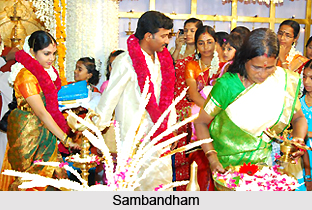 Sambandham is a form of morganatic marriage peculiar to the state of Kerala by which the younger sons of Brahmin families could form relationships with Nair women, the children remaining Nayars and thus introducing a new element into the race. The custom of the Sambandham marriage of Namboodiri Brahmins to Kshatriya, Ambalavasi or Nayar women ensured their dominance, particularly since in important families they made sure that the sons of Brahmins were in control.
Sambandham is a form of morganatic marriage peculiar to the state of Kerala by which the younger sons of Brahmin families could form relationships with Nair women, the children remaining Nayars and thus introducing a new element into the race. The custom of the Sambandham marriage of Namboodiri Brahmins to Kshatriya, Ambalavasi or Nayar women ensured their dominance, particularly since in important families they made sure that the sons of Brahmins were in control.
The society in medieval Kerala was shaped not only by caste, but also by the parallel systems of matrilineal and patrilineal inheritance. The matrilineal system was known as Marumakkathayam, was probably the most widespread; it was followed by Nayars, Kshatriya, Ambalavasis and Moplahs or Muslims of Malayali race, and partially by the Ezhavas and the outcaste groups. Among Hindus, the Brahmins and the Kamalla castes of craftsmen were the principal groups who followed Makkathayam or patrilineal inheritance.
The patrilineal joint family of the Namboodiri Brahmins was called the illom, and had its own peculiarities. Only the eldest male member of the illom was allowed to marry women of his own caste; he was allowed polygamy to the extent of four wives. Nevertheless there were large numbers of young Namboodiri women condemned to lives of perpetual spinsterhood within the seclusion of the household and, of course, many younger sons and brothers in every illom who did not expend their physical energies on either farming or warfare.
The custom of Sambandham persisted in the rural areas in Kerala to the end of the nineteenth century. Sambandham was an imposition that carried its own punishment. Every child of such a union took the caste of its mother, while the custom asserted the social superiority of the Namboodiris; it increased the numerical strength of the castes below them. At the same time, the fact that only the sons of one member of each illom were legitimate Brahmins meant that the strength of the priestly caste declined, not merely in relation to the increasing numbers of Nayars and Ezhavas, but even absolutely, so that during the nineteenth century when reliable statistics were at last available, the dwindling of these lords of the creation of Parasurama became quite evident.
The reintroduction of the matrilineal system in castes below the Brahmins does not seem to have taken place until the tenth century; there are no Keralan inscriptions dating from before that century which indicate matrilineal property relationships. The reintroduction of the matrilineal system was coincidental with the coming to power of the Namboodiri Brahmins. The matrilineal system, combined with the custom of the Sambandham marriage of Namboodiris to Kshatriya, Ambalavasi or Nayar women, ensured their dominance, particularly since in important families they made sure that the sons of Brahmins were in control. Whatever their origins, the two parallel systems of inheritance and family organization, Marumakkathayam and Makkathayam, together with Sambandham concubine, were clearly established by the time the historical record begins to become clear during the earlier parts of the tenth century, and they formed an important part of the structure of Hindu society by the time the first European observers arrived.






